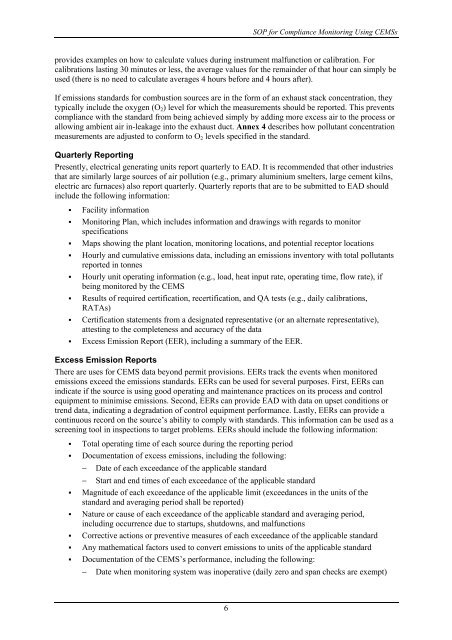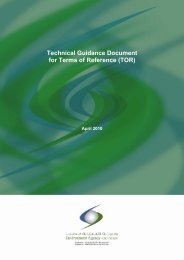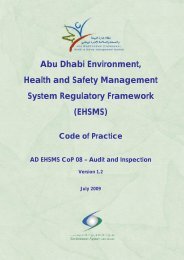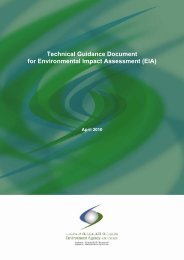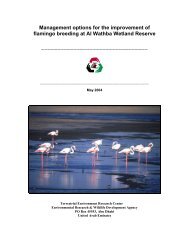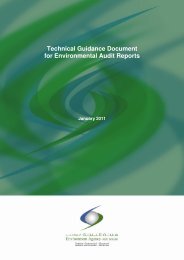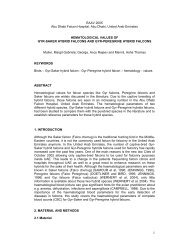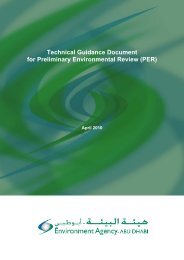Standard Operating Procedure (SOP) for Compliance Monitoring ...
Standard Operating Procedure (SOP) for Compliance Monitoring ...
Standard Operating Procedure (SOP) for Compliance Monitoring ...
You also want an ePaper? Increase the reach of your titles
YUMPU automatically turns print PDFs into web optimized ePapers that Google loves.
<strong>SOP</strong> <strong>for</strong> <strong>Compliance</strong> <strong>Monitoring</strong> Using CEMSs<br />
provides examples on how to calculate values during instrument malfunction or calibration. For<br />
calibrations lasting 30 minutes or less, the average values <strong>for</strong> the remainder of that hour can simply be<br />
used (there is no need to calculate averages 4 hours be<strong>for</strong>e and 4 hours after).<br />
If emissions standards <strong>for</strong> combustion sources are in the <strong>for</strong>m of an exhaust stack concentration, they<br />
typically include the oxygen (O 2 ) level <strong>for</strong> which the measurements should be reported. This prevents<br />
compliance with the standard from being achieved simply by adding more excess air to the process or<br />
allowing ambient air in-leakage into the exhaust duct. Annex 4 describes how pollutant concentration<br />
measurements are adjusted to con<strong>for</strong>m to O 2 levels specified in the standard.<br />
Quarterly Reporting<br />
Presently, electrical generating units report quarterly to EAD. It is recommended that other industries<br />
that are similarly large sources of air pollution (e.g., primary aluminium smelters, large cement kilns,<br />
electric arc furnaces) also report quarterly. Quarterly reports that are to be submitted to EAD should<br />
include the following in<strong>for</strong>mation:<br />
• Facility in<strong>for</strong>mation<br />
• <strong>Monitoring</strong> Plan, which includes in<strong>for</strong>mation and drawings with regards to monitor<br />
specifications<br />
• Maps showing the plant location, monitoring locations, and potential receptor locations<br />
• Hourly and cumulative emissions data, including an emissions inventory with total pollutants<br />
reported in tonnes<br />
• Hourly unit operating in<strong>for</strong>mation (e.g., load, heat input rate, operating time, flow rate), if<br />
being monitored by the CEMS<br />
• Results of required certification, recertification, and QA tests (e.g., daily calibrations,<br />
RATAs)<br />
• Certification statements from a designated representative (or an alternate representative),<br />
attesting to the completeness and accuracy of the data<br />
• Excess Emission Report (EER), including a summary of the EER.<br />
Excess Emission Reports<br />
There are uses <strong>for</strong> CEMS data beyond permit provisions. EERs track the events when monitored<br />
emissions exceed the emissions standards. EERs can be used <strong>for</strong> several purposes. First, EERs can<br />
indicate if the source is using good operating and maintenance practices on its process and control<br />
equipment to minimise emissions. Second, EERs can provide EAD with data on upset conditions or<br />
trend data, indicating a degradation of control equipment per<strong>for</strong>mance. Lastly, EERs can provide a<br />
continuous record on the source’s ability to comply with standards. This in<strong>for</strong>mation can be used as a<br />
screening tool in inspections to target problems. EERs should include the following in<strong>for</strong>mation:<br />
• Total operating time of each source during the reporting period<br />
• Documentation of excess emissions, including the following:<br />
− Date of each exceedance of the applicable standard<br />
− Start and end times of each exceedance of the applicable standard<br />
• Magnitude of each exceedance of the applicable limit (exceedances in the units of the<br />
standard and averaging period shall be reported)<br />
• Nature or cause of each exceedance of the applicable standard and averaging period,<br />
including occurrence due to startups, shutdowns, and malfunctions<br />
• Corrective actions or preventive measures of each exceedance of the applicable standard<br />
• Any mathematical factors used to convert emissions to units of the applicable standard<br />
• Documentation of the CEMS’s per<strong>for</strong>mance, including the following:<br />
− Date when monitoring system was inoperative (daily zero and span checks are exempt)<br />
6


